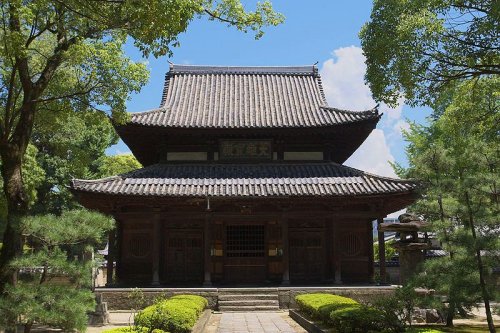Fukuoka 福岡市) is the capital of Fukuoka Prefecture on the island of Kyushu in Japan. The city is on the northern shore of the island. It was granted city status on 1 April, 1972, and is the biggest city west of Osaka. It has a population of 1.45 million and is within Greater Fukuoka, which has 2.5 million inhabitants.
Fukuoka is one of the oldest cities in Japan, and certainly among the oldest non-Jōmon settlements in the country. Its history goes back to AD 663 when a settlement by the name of Dazaifu was established here. The oldest part of Fukuoka is the settlement known as Hakata. Today Hakata is a ward, or neighbourhood, in downtown Fukuoka.
 Fukuoka, Japan
Fukuoka, JapanSource: http://commons.wikimedia.org/wiki/File:Fiume_Nakagawa.JPG
Author: Eejyanaika

Author: Eejyanaika

Places of Interest in Fukuoka
- Tenjin
Commercial and shopping district of Fukuoka. - Nakasu
Entertainment district of Fukuoka, with nightclubs, restaurants and bars. - Momochi
New waterfront precinct of Fukuoka. - Fukuoka Tower
Tallest seaside tower in Japan. - Hawks Town
Resort development in Fukuoka. - Fukuoka City Museum
Museum that chronicles the history of the city and its relationship with its Asian neighbours. - Shofuku-ji Temple
Oldest Zen Buddhist temple in Japan. - Kushida Shrine
Shinto shrine from the 8th century. - Hakata Machiya Folklore Museum
Museum with exhibits and dioramas that celebrates the heritage of the Hakata Machiya area. - Canal City
A massive shopping mall in Fukuoka. - Asian Art Museum
Museum with a good collection of Asian art. - Sumiyoshi Shrine
Shrine that hosts the annual sumo-wrestling festival. - Ohori Park
Popular green space in Fukuoka.
In response to the invasion, the Japanese erected a 20-km stone barrier bordering the coast of Hakata Bay, where Fukuoka is located. An archaeological excavation of the ancient barrier was carried out in the 1930's.
 Shoufukuji Temple, Fukuoka
Shoufukuji Temple, FukuokaSource: http://commons.wikimedia.org/wiki/File:Shoufukuji02.jpg
Author: Pontafon

Author: Pontafon

Kublai Khan sent another envoy to Japan in 1279. The Japanese responded by beheading five of the emissaries. Infuriated, the Khan sent an armada of 4,000 ships and 140,000 soldiers to invade Japan. Once again a mighty typhoon dealt a severe blow to the Mongolian fleet. The typhoon soon became known as Kamikaze, or divine winds.
Fukuoka was traditionally the residence of the daimyo while Hakata was the port and merchant district. When these two towns merged, it was initially decided that the newly established town should be known as Hakata. However, the samurais gatecrashed the meeting and insisted that it be known as Fukuoka. For that reason, Fukuoka is today the name of the city, whereas the central core continues to be known as Hakata.
Planning your trip to Fukuoka
If you are coming from Tokyo, flying is faster and not significantly more expensive. The one-way fare by Skymark Airlines from Tokyo Haneda to Fukuoka is ¥19,800 while the Nozomi Shinkansen bullet train from Tokyo Station is ¥22,320. The flight takes two hours, the train five. Of course, if you hold a Japan Rail Pass, then price comparison is immaterial. However it cannot be used on the Shinkansen, rather you need to take the Hikari train and change to the Hikari Rail Star en route. The change is usually at Shin Osaka station. Be sure you check the train timetable for the best connection.Fukuoka International Airport is located surprisingly close to downtown Fukuoka - a mere two subway stops from the Hakata JR Station in the city centre. There are four terminals. The subway station is located at Terminal 2, which receives flights from Tokyo, Osaka, Nagoya, Sapporo and Okinawa. Terminal 1 handles flights from smaller cities in Japan. Terminal 3 is not used for departing flights which the fourth terminal, called the International Terminal, is a 10-minute bus transfer from Terminal 2.
Planning your travel within Fukuoka
There are three subway lines in Fukuoka. At the city centre, right under the JR Hakata Railway Station, is the Hakata subway station. The fare to Fukuoka airport takes 6 minutes and costs ¥250. If you are going to take the train quite a bit, I suggest you either get the Ichinichi Johshaken pass which allows unlimited rides per day for ¥600, or the stored-value F-Cards that come in denominations of ¥1000, ¥3000 and ¥5000, but give you stored values of ¥1100, ¥3300 and ¥5700 respectively. There are also the Yokanet Cards and the WaiWai Cards, all with discounts or added value that you can use. Latest updates on Penang Travel Tips
Latest updates on Penang Travel Tips
 Map of Roads in Penang
Map of Roads in Penang
Looking for information on Penang? Use this Map of Roads in Penang to zoom in on information about Penang, brought to you road by road.
Copyright © 2003-2025 Timothy Tye. All Rights Reserved.

 Go Back
Go Back